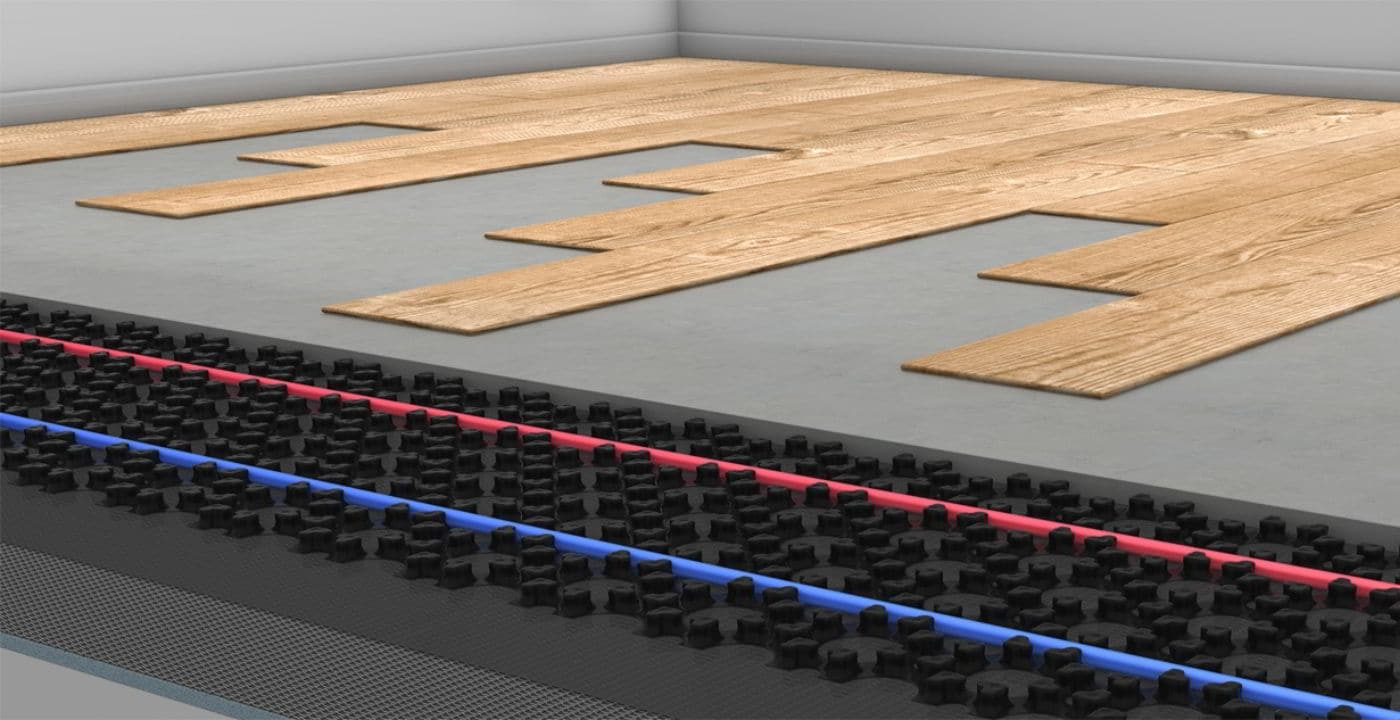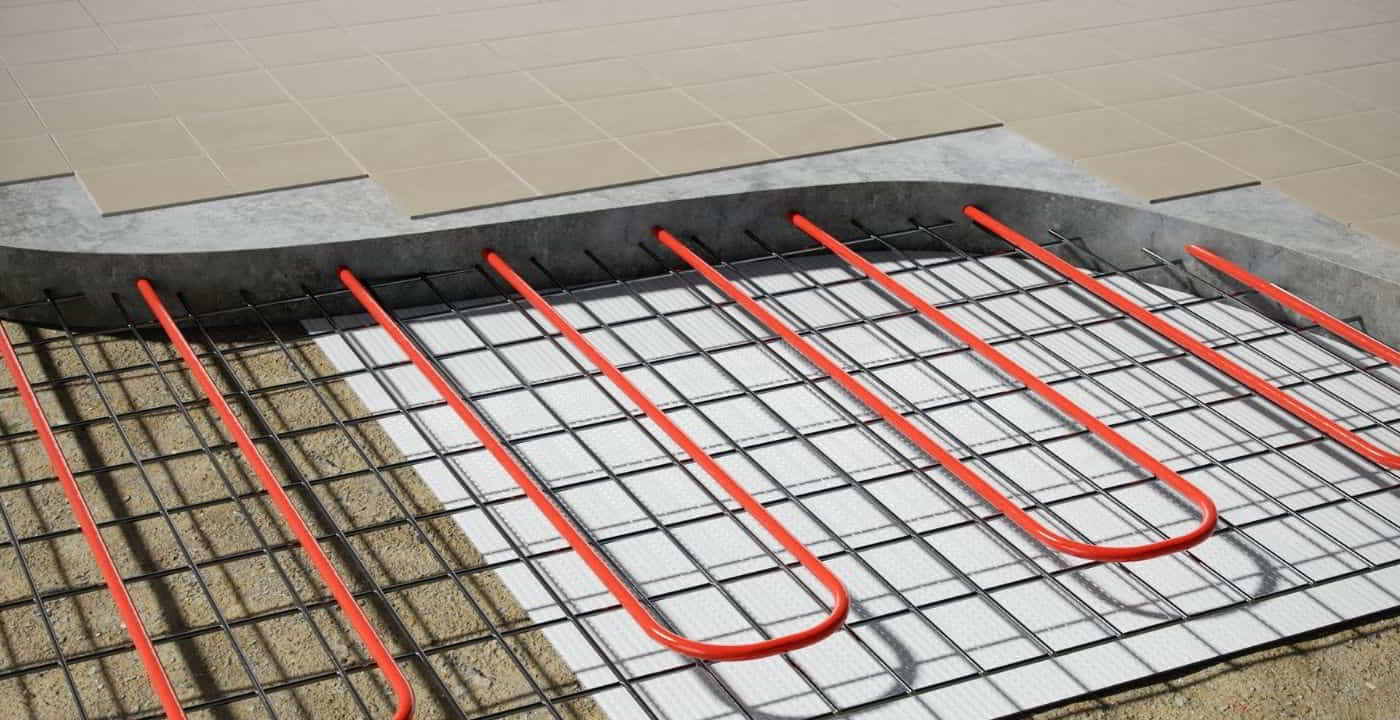Key Takeaways
- Radiant floor heating systems need insulation under concrete slabs to achieve peak energy efficiency and to prevent downward heat loss.
- Expanded Polystyrene (EPS) and Extruded Polystyrene (XPS) dominate as top-tier insulation materials for under concrete slab applications.
- Correct installation ensures that the insulation’s efficacy is maintained, leading to more consistent heat and prolonged energy savings.
Why does radiant heat need insulation under concrete?
Radiant heat, by design, provides warmth directly to the floor above it. Without apt insulation, a significant portion of this heat would be lost to the concrete slab below due to its high conductivity and meager insulative qualities
Even though the Department of Energy states that electric radiant heating systems are most “… cost-effective if they include a significant thermal mass such as a thick concrete floor…” a concrete slab can quickly draw away the radiant heat, making your system far less efficient and driving up energy costs if it isn’t insulated.
Proper insulation acts as a heat redirect, ensuring that warmth is pushed upwards to warm your feet and room rather than lost to the ground.
For a real deep dive into why insulation is vital for radiant heating under slab the Radiant Professionals Alliance Association (non-profit) has a concise 1-page overview of the science and costs here.
What is floor profile build up and why does it matter?

Floor profile build-up refers to the layers that constitute the flooring system. For radiant floor heating systems, this typically includes the concrete slab, insulation, heating elements, and the final flooring material.
The arrangement and quality of these layers directly influence the system’s performance and longevity. Proper insulation, for instance, not only prevents heat loss but also facilitates even heat distribution.
The thickness and type of the final flooring material can also impact how heat is transferred to the living space. Thus, understanding and optimizing floor profile build-up is essential for the best performance of a radiant heating system.
What's the best under slab insulation for radiant heat?

There are two primary contenders when it comes to under slab insulation: Expanded Polystyrene (EPS) and Extruded Polystyrene (XPS).
- EPS (Expanded Polystyrene): Recognizable as Styrofoam, EPS boasts a low water absorption rate, making it ideal for under slab insulation. It offers an R-value of about 3.6 per inch and retains this insulative property over extended periods.
- XPS (Extruded Polystyrene): Often found in blue or pink sheets, XPS offers a superior R-value of around 4.7 per inch. However, this insulative capacity diminishes over time. Despite this, its lower absorption rate compared to EPS makes it a popular choice for radiant floor heat insulation under concrete.
Understanding Foam Boards and Blankets for Radiant Heating Insulation

In the arena of radiant floor heating insulation, while the emphasis is often on EPS and XPS foam boards, there’s more to the story.
The world of insulation also sees the incorporation of foam boards and blankets, each offering unique advantages that cater to specific project needs.
Foam Boards
Foam boards, typically made of polystyrene, polyisocyanurate, and polyurethane, are rigid panels that can be used to insulate virtually any part of the home, from the roof to the foundation. Here’s a closer look:
- Versatility: Foam boards can be used in both residential and commercial buildings, presenting a flexible solution irrespective of the scale.
- Durability: Given their rigid structure, foam boards offer longevity and can resist typical wear and tear better than some other insulation forms.
- Water Resistance: Most foam boards come with a low water absorption rate. This characteristic makes them particularly advantageous for radiant floor heating systems, where moisture resistance is paramount.
- High R-Value: Foam boards are renowned for their high R-value, translating to superior insulating capabilities. This ensures minimal heat loss and optimal functioning of the radiant heating system.
Insulation Blankets
Insulation blankets, often made of fiberglass, mineral wool, or natural fibers, provide an alternative to rigid board solutions:
- Flexibility: Unlike foam boards, insulation blankets can be rolled or folded, offering easier transportation and installation, especially in tight spaces.
- Sound Dampening: Beyond thermal insulation, blankets often possess soundproofing qualities, making them a double-duty solution.
- Economical: In many instances, insulation blankets tend to be more affordable than their foam board counterparts, providing budget-conscious individuals a viable option.
- Environmental Edge: With options derived from natural fibers, insulation blankets can appeal to those seeking eco-friendly solutions
Which One is Right for Your Project?
Choosing between foam boards and insulation blankets largely hinges on your specific requirements:
- Space Considerations: Foam boards, with their rigid structure, might be more suited to expansive areas or new constructions, while the roll-out nature of blankets might be ideal for renovations or tighter spaces.
- Budget: If you’re working within a tighter budget, insulation blankets might be the more economical choice.
- Longevity and Performance: For those prioritizing lifespan and maximum energy efficiency, foam boards, particularly EPS and XPS, may take the lead due to their durable nature and superior R-values.
- Environmental Concerns: For the eco-conscious, insulation blankets, especially those made from natural fibers, can be a sustainable choice.
How much does insulation for radiant heat under concrete slabs cost?
The cost of insulation varies based on the material type, thickness, and brand.
On average, you can expect to pay between $0.75 to $2.00 per square foot for EPS and $1.00 to $3.00 per square foot for XPS.
Factors like regional pricing differences, installation complexities, and project size can further influence the final cost.
Follow the link to find out more about how much radiant floor heating costs – our in depth look into current prices.
How long does concrete slab radiant heat insulation last?
Insulation materials like EPS and XPS, when shielded from undue stresses and extreme environmental factors, can last anywhere between 25 to 30 years.
Aiding in their longevity is their resistance to moisture, reduced risk of physical damage once encased in concrete, and their general chemical inertness.
How to install radiant floor heat in concrete

The proper installation process is pivotal for the insulation’s longevity and effectiveness:
- Prepare the Surface: Start with a prepped and graded gravel area, ensuring it’s devoid of debris.
- Lay Down the Insulation: Unroll the chosen insulation, letting it rise about 6 inches up the side walls.
- Tape it Up: Employ white adhesive insulation tape for sealing rolls at the seams, a step ensuring the vapor barrier’s integrity.
- Add Sand: Spread a 1-inch layer of sand atop the insulation. This assists in draining water and can potentially expedite the concrete curing process.
- Pour the Concrete Slab: Now you are all set to pour the concrete slab as per typical standards, taking care not to damage the insulation layer.
Supplemental Solutions to Boost Radiant Heating Efficiency
If you missed the boat on under slab insulation, or you want to augment your under slab insulation, there are additional methods available to enhance your radiant heating efficiency:
- Over Slab Insulation: By placing insulation like EPS or XPS atop the existing concrete slab and then layering with plywood subfloors, you can reduce heat loss considerably.
- Insulated Underlay: Products like the 4-in-1 Ultralight™ insulation boards can drastically augment your radiant floor heating’s performance. These boards insulate, evenly distribute heat, protect tile floors from fluctuating subfloors, and even offer notable acoustic benefits.
Concrete Slabs as Innovative Thermal Batteries
Here at Green Wave Distribution, we aim to deliver the cutting edge of energy efficiency with our innovative radiant heating systems.
As part of this goal, we have developed a novel approach that transforms a building’s concrete slab into a thermal battery. It’s an innovation genuinely pushing the boundaries of comfort and energy conservation.
The true genius of our system lies in its design. We embed the STEP HEAT system directly into the concrete, leveraging its natural properties to create a thermal reservoir. This reservoir captures warmth efficiently and releases it gradually.
As our Operations Manager, Drew Mauro, confidently states, “It’s the most efficient way to heat a structure,”
It’s not only incredibly efficient, but it’s also extremely reliable and effective.
During a multi-day power outage caused by a sudden cold-snap, one of our clients was able to maintain an interior temperature of 68 degrees in their home for over 3 days using this system because of the energy it had stored.
How does it work?
Using the principle of thermal mass, our radiant heating method turns the concrete slab into a heat cache.
It accumulates excess heat during times when electricity is cheaper and gradually dispenses it, ensuring a uniform and cozy indoor environment.
Operating at a mere 3-4 watts/ft², the STEP HEAT system’s energy consumption is notably below conventional heating solutions, translating to significant energy and financial benefits.
The dual advantages of decreased electrical intake and a more compact system further cut down on expenses.
Projected Energy Savings:
Our approach forecasts a remarkable 40-50% energy conservation compared to established heating techniques.
The fusion of using electricity during cost-effective hours and the efficient heat dispersal is the secret behind these significant savings.
Transforming concrete slabs into thermal repositories offers numerous advantages:
- Superior Energy Conservation: With diminished dependence on active heating, the system greatly reduces energy consumption and lessens ecological strain.
- Uniform Comfort: By adjusting to temperature shifts, the system guarantees consistent warmth.
- Economic Efficiency: The strategic energy consumption slashes utility costs, offering enduring financial benefits.
- Sturdiness and Trustworthiness: Capitalizing on the durable nature of concrete ensures the system’s sustained performance.
- Maximized Space: By removing the need for separate heaters, space is freed up, enhancing the overall look and feel of interiors.
In turning concrete slabs into thermal powerhouses, we are ushering in a paradigm where comfort and energy efficiency are harmoniously intertwined, reshaping the landscape of energy-savvy heating solutions.
The importance of Insulation for this solution is just as, if not more, important than standard radiant floor heating systems.
Oklahoma State University carried out research on “using a mass radiant floor with a geothermal system as a thermal battery of the building.” While they were using a hydronic energy source, the same principle applies to electric radiant heating.
They found that “…thermal insulation is the key driver of BaB system thermal efficiency.”
As such, the importance of insulation to any of these concrete slab heating solutions cannot be overstated.
FAQs
Do you need insulation under radiant floor heat?
Undoubtedly. Insulation under radiant floor heat is non-negotiable for optimal efficiency and ensuring warmth is directed where it’s needed.
How often should under slab insulation be checked or maintained?
Once installed and shielded by concrete, under slab insulation is virtually maintenance-free.
However, checking the structural integrity of the concrete slab every few years can indirectly ensure the insulation remains uncompromised.
How often should under slab insulation be checked or maintained?
Once installed and shielded by concrete, under slab insulation is virtually maintenance-free.
However, checking the structural integrity of the concrete slab every few years can indirectly ensure the insulation remains uncompromised.
Can radiant heat insulation be retrofitted?
Unfortunately, under slab insulation cannot be retrofitted after the house construction is complete.
That being said, over-slab insulation techniques offer alternative solutions for those looking to enhance their radiant heating system’s efficiency post-construction.
What are the signs of failing under slab insulation?
Decreased heating efficiency, unexpected spikes in energy bills, or uneven heating could indicate issues with the insulation layer beneath the concrete slab.
Is insulation necessary for the system?
Yes. There’s a misconception that heat only rises. While hot air does rise, heat moves in every direction seeking cold areas.
Without proper insulation, any radiant heating system will direct its heat downwards to the cold slab instead of upwards, warming the room.
Insulation comes in various thicknesses and R-values. Our Green Wave Distribution experts will guide you in choosing the perfect insulation for your needs.
Is it possible to heat my entire basement with this system?
Absolutely. Our radiant heating designs can serve as the primary heat source for your basement.
What's the cost range for the system?
The typical expenditure for our system ranges from $12.00 to $14.00 per ft².
How energy efficient is the system?
Our state-of-the-art radiant heating system operates on a mere 24V ESLV (Extra Safe Low Voltage) and offers more extensive coverage than traditional wire or tube systems.
This design ensures lower energy consumption while delivering superior comfort and safety levels.
A unique feature of our STEP HEAT system is its self-regulation. It acts as an adaptive temperature sensor, adjusting its output in real-time to temperature shifts.
Can I undertake the installation myself?
While most of the installation process can be managed by homeowners or contractors, local regulations might vary.
]However, connecting the transformer to the electrical panel will require a professional electrician.
Conclusion
Securing the right radiant floor heating concrete slab insulation is more than just a luxury—it’s a necessity for efficient, long-lasting, and effective heating.
Whether you lean towards EPS or XPS, committing to quality and correct installation practices will serve you well in the long run.
Always engage with professionals, research well, and invest in the best to ensure your living spaces remain warm and inviting.
Radiant heating is becoming a major player for in-home heating, not just basements and driveways. Find out more about Radiant Heat Mats for your home with Green Wave Distribution.





